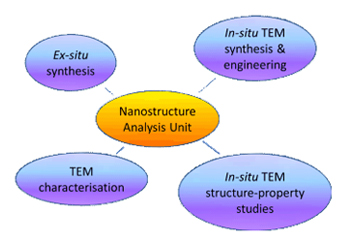mainmenu
To explore new physics phenomena of low dimensional materials
with a special emphasis on two-dimensional layered structures
Introduction
Structural analysis group
The Nanostructure Analysis Unit will provide world-class electron microscopy facilities and expertise in the field of nanostructure analysis.
The unit will seek not only to provide in-depth characterization based on state-of-the-art electron microscopy and incorporated spectroscopy, but also provide leading research in understanding the growth mechanisms and structure-property relationships of nanostructures and nano-devices though state-of-the-art transmission electron microscopy in-situ techniques.
Figure 1 provides an overview of the four primary areas of the Nanostructure Analysis Unit.
Our focus on nano-materials
The promise nano-materials offer in terms of tailored properties (e.g. electronic, chemical and mechanical) has led to massive efforts around the globe. Some nano-materials are already beginning to make a positive impact in our lives. However, many nano-materials are not reaching their true potential due to technical difficulties.
One of the most relevant bottlenecks lies in the controlled synthesis of nano-materials.

Figure 1. Overview of the Nanostructure Analysis Unit
This is because, for the most part, the control required is at the atomic scale. For example, graphene nanoribbons can open an energy gap making them extremely interesting for graphene based electronics.
However, their electronic properties are extremely sensitive to their edge termination. In short, because the physical properties of nano-materials are so sensitive to small structural changes there is a crucial need to be able to fabricate and engineer them in a reproducible manner with atomic precision.
Understanding nano-material fabrication, engineering and structure-property relationships at the atomic-scale is crucial and lies at the heart of the research to be conducted at the nanostructure analysis unit.
Research Teams
- Prof. Sang Ho Oh
- Prof. Young-Min Kim
- Dr. Jiwon Jeong









